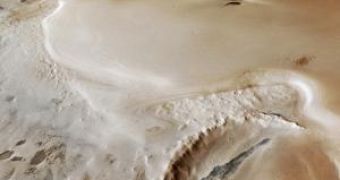The Promethei Planum was previously a subject of study for ESA's Mars Express High Resolution Stereo Camera, which probed it back in September 2005, while being in a high orbit around the Red Planet. Now, new observations conducted with the Mars Advanced Radar for Ionoshpere and Subsurface Sounding, or MARSIS for short, reveals that south pole is covered with a layer of ice exceeding 3,500 meters in thickness.
The images relayed back to Earth have a ground resolution of 40 meters per pixel. Promethei Planum lies 76 degrees south and 105 degrees east, meaning it is located in the south polar region on Mars. Within it, the Mars Express spacecraft was able to reveal an impact crater, measuring 100 kilometers in width and about 800 meters in depth, with the interior partially covered in ice.
Near the location of the crater, what appear to be lava flows created by volcanic activity can be found as well, being also covered with a considerable sheet of ice. Towards the bottom of the image sent by the Mars Express orbiter, you can clearly see dark features most likely consisting of dust from the lava flows or volcanic ashes spewed into the surrounding areas during a volcanic eruption.
Promethei Planum's layer of ice is basically an extension of the south polar ice cap towards the south regions of the lava flow. While most of the areas have been covered by red dust, found almost anywhere of the Red Planet, the flanks of the ice sheet seem to contain white, relatively clean ice material, with an estimated layer thickness between 900 to 1,100 meters.
These latest surveys conducted with the Mars Advanced Radar for Ionosphere and Subsurface Sounding tool on board Mars Express orbiter, lead to the conclusion that the mass of ice deposited at the north and south poles of the planet makes up for the largest water reservoir on Mars, meaning that, if it is to melt one day, it could flood the whole surface with an ocean of water averaging about eleven meters in depth.

 14 DAY TRIAL //
14 DAY TRIAL //